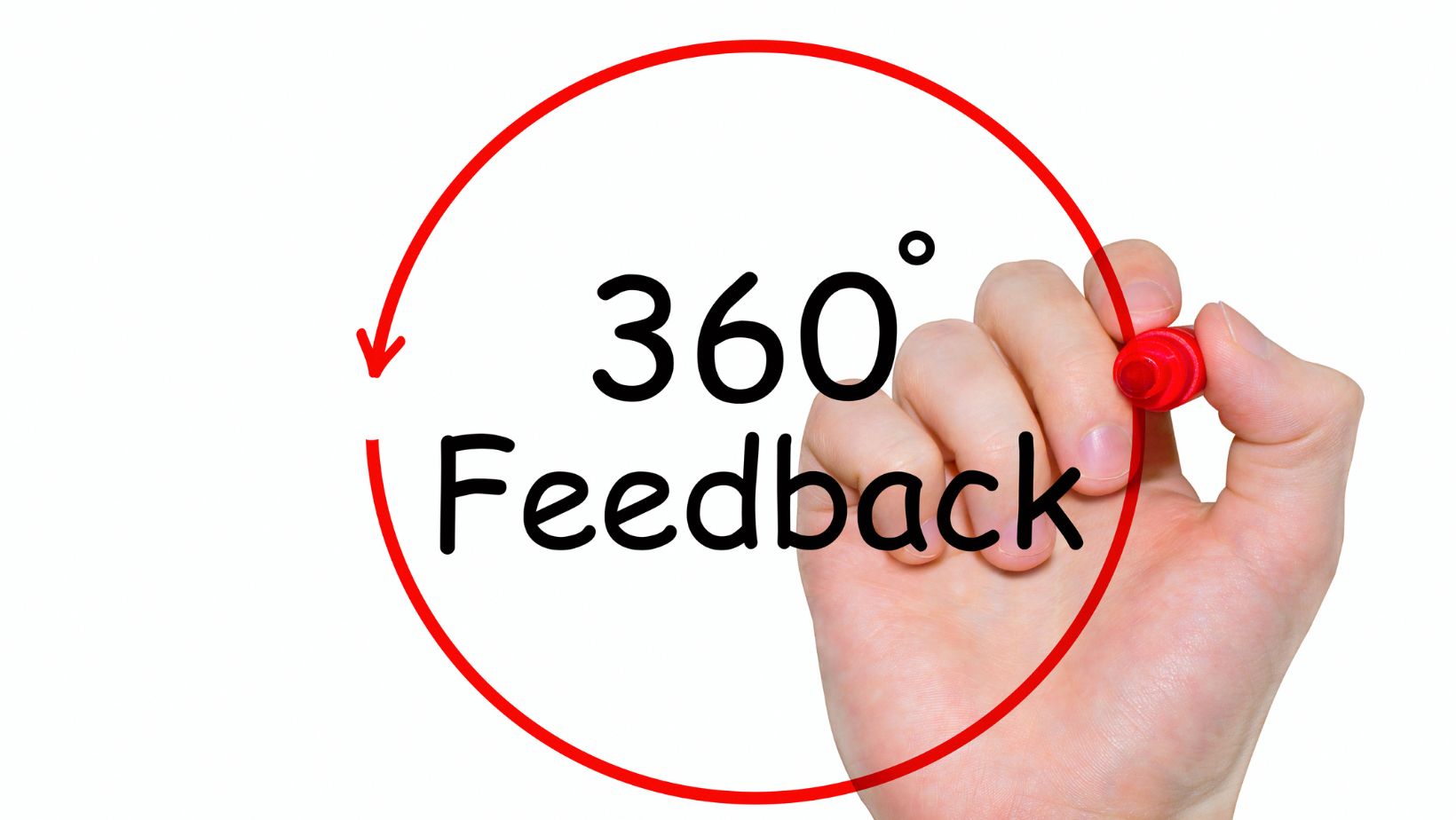
360-degree feedback has become a cornerstone of modern performance management, offering organizations a comprehensive view of employee performance from multiple perspectives. This multi-source evaluation method collects insights from managers, peers, subordinates, and even customers to create a complete picture of an individual’s strengths and development areas.
Unlike traditional top-down performance reviews, 360-degree feedback provides a balanced assessment that eliminates bias and delivers actionable insights. The process encourages self-awareness, promotes professional growth, and builds stronger workplace relationships through transparent communication and mutual understanding.
This guide presents 20 practical 360 feedback examples across different categories, along with implementation strategies and common pitfalls to avoid. These examples will help you conduct more effective performance reviews and create a culture of continuous improvement within your company.
Why you Need 360 Feedback
Traditional performance reviews rely on single perspectives that often miss critical aspects of employee performance. 360-degree feedback addresses these limitations by gathering comprehensive insights from multiple sources, creating more accurate and actionable evaluations.
Eliminates Blind Spots and Bias
Single-source feedback creates dangerous blind spots in performance evaluation. Managers may not witness daily collaboration, peer interactions, or leadership moments that occur outside their direct observation.
360 feedback reveals patterns across different relationships and situations. When multiple sources consistently highlight the same strengths or development areas, it provides reliable data that single perspectives cannot match.
Increases Self-awareness and Accountability
Multi-perspective feedback helps employees understand how their actions impact different stakeholders. This awareness often surprises individuals who may not realize how their communication style or leadership approach affects various team members.
When employees receive consistent feedback from multiple sources, they become more accountable for their development. The comprehensive nature of 360-degree feedback examples makes it harder to dismiss concerns as isolated opinions or personal conflicts.
Builds Stronger Team Dynamics
Regular 360 feedback creates a culture of open communication and mutual support. Team members become more comfortable giving and receiving constructive feedback, leading to improved collaboration and trust.
The process encourages empathy as employees learn to see situations from multiple perspectives. This understanding strengthens working relationships and reduces conflicts by promoting better communication and shared accountability.
Provides Data-driven Development Insights
360 feedback generates valuable organizational data about team performance, communication gaps, and leadership effectiveness. This information helps HR teams and executives make informed decisions about training programs and resource allocation.
The comprehensive feedback from performance management software also identifies high-potential employees and future leaders more accurately than traditional reviews. Organizations can spot emerging talent and leadership qualities that might otherwise go unnoticed in single-source evaluations.
20 Examples of 360 Feedback
Effective 360 feedback examples require specific, actionable statements that provide clear guidance for improvement and recognition of strengths. The following examples are organized by relationship type to help you deliver meaningful feedback across different workplace dynamics and responsibilities.
360 Feedback Examples for Managers
Manager feedback focuses on leadership effectiveness, decision-making abilities, and team development skills. These 360 feedback for manager examples help evaluate how well managers guide their teams and create positive work environments.
- You consistently provide clear direction and set realistic expectations, which helps the team stay focused and motivated even during challenging projects.
- Your open-door policy and willingness to listen to team concerns creates a supportive environment where everyone feels comfortable sharing ideas and asking for help.
- You excel at recognizing individual team members’ strengths and assigning tasks that leverage their unique skills, leading to higher quality outcomes and job satisfaction.
- Your decision-making process could benefit from more input from team members, as involving them in strategic discussions would increase buy-in and improve implementation.
- You demonstrate strong conflict resolution skills by addressing issues promptly and fairly, helping maintain positive team dynamics and preventing small problems from escalating.
360 feedback examples for peers
Peer feedback examples evaluate collaboration, communication, and professional relationships among colleagues at the same level. These examples assess how effectively someone works within their team and contributes to shared goals.
- Your willingness to share knowledge and mentor newer team members significantly contributes to our collective success and creates a positive learning environment.
- You consistently meet deadlines and deliver high-quality work, which allows the rest of the team to rely on your contributions and plan accordingly.
- Your creative problem-solving approach often leads to innovative solutions that benefit the entire team and improve our processes and outcomes.
- You could improve team collaboration by providing more regular updates on your projects, as this would help prevent duplicated efforts and improve coordination.
- Your positive attitude during stressful situations helps maintain team morale and keeps everyone focused on finding solutions rather than dwelling on problems.
360 Feedback Examples for Self-assessment
Self-assessment feedback encourages honest self-reflection and helps employees identify their own strengths and development areas. These examples of 360 feedback promote accountability and personal growth.
- I recognize my strength in analytical thinking and problem-solving, which has helped me contribute valuable insights to complex projects and decision-making processes.
- I acknowledge that my communication style can sometimes be too direct, and I’m working on being more diplomatic while still conveying important information effectively.
- I excel at building relationships with clients and stakeholders, which has resulted in stronger partnerships and increased business opportunities for the team.
- I need to improve my time management skills, particularly in balancing multiple priorities and ensuring that urgent tasks don’t overshadow important long-term projects.
- I value continuous learning and actively seek feedback from others, which has helped me grow professionally and adapt to changing business requirements.
360 Feedback Examples for Subordinates
Subordinate feedback provides valuable insights into leadership effectiveness from the perspective of direct reports. These will help you learn how to give 360 feedback to your boss examples.
- You provide regular feedback and recognition that helps me understand my performance and feel valued for my contributions to the team’s success.
- Your coaching approach has significantly improved my skills and confidence, particularly in areas where I initially struggled or felt uncertain about my abilities.
- You effectively shield the team from unnecessary organizational politics and distractions, allowing us to focus on our core responsibilities and deliver better results.
- You could improve by being more available for quick questions and guidance, as sometimes delays in getting direction can slow down project progress.
- Your transparent communication about company changes and team objectives helps me understand the bigger picture and align my work with organizational goals.
How to Implement 360-degree Feedback Examples
A successful 360 feedback software implementation requires careful planning and clear processes to ensure meaningful results. The key is creating a structured approach that encourages honest feedback while maintaining confidentiality and trust.
Establish Clear Objectives and Process
Define specific goals for your 360 review feedback before launching it. Whether you’re focusing on leadership development, improving team collaboration, or enhancing overall performance, clear objectives guide the entire process and help participants understand the purpose. Establish standardized procedures for collecting, analyzing, and delivering feedback to ensure consistency across all evaluations.
Create detailed guidelines that outline who participates, what types of feedback to provide, and how the information will be used. This transparency builds trust and encourages more honest, constructive responses from all participants.
Select Appropriate Participants and Tools
Choose feedback providers who have regular interaction with the person being evaluated and can offer meaningful insights. Typically, this includes 3-5 people from each category (managers, peers, subordinates) to ensure diverse perspectives while keeping the process manageable.
Invest in reliable feedback collection tools that protect anonymity and streamline the process. Many software platforms offer customizable surveys, automated reminders, and analytics features that make implementation more efficient and effective.
Create Development Action Plans
Transform 360-degree feedback examples into actionable development plans that specify concrete steps for improvement. Work with employees to identify 2-3 key areas for focus, establish measurable goals, and create timelines for progress. Regular check-ins and follow-up sessions ensure that feedback leads to actual behavioral changes and skill development.
Provide resources such as training programs, mentoring opportunities, or coaching sessions to support employees in their development journey. This demonstrates organizational commitment to growth and increases the likelihood of successful outcomes.
Mistakes to Avoid When Implementing 360 Feedback
While employee feedback software can be highly effective, several common mistakes can undermine its success and create negative experiences for participants. Understanding these pitfalls helps organizations implement more successful programs.
Treating it As a One-time Event
Many organizations make the mistake of conducting 360 feedback as an annual or semi-annual event rather than integrating it into ongoing performance management.
This approach limits its effectiveness because feedback becomes outdated quickly and there’s insufficient time to track progress or adjust development plans based on changing circumstances.
Focusing Only on Weaknesses
Another critical error is emphasizing areas for improvement while neglecting to acknowledge and reinforce strengths. This imbalanced approach can demoralize employees and create a negative association with the feedback process. An effective 360 feedback strengths and weaknesses example celebrates accomplishments while addressing development needs.
Lack of Follow-through
Collecting feedback without proper follow-up and action planning renders the entire process ineffective. When organizations fail to help employees create development plans or provide resources for improvement, the feedback becomes meaningless data rather than a catalyst for growth.
Insufficient Training for Participants
Many programs fail because participants don’t understand how to give or receive constructive feedback effectively. Without proper training, feedback providers may offer vague comments or harsh criticism, while recipients may become defensive or fail to act on the insights they receive.
Conclusion
360-degree feedback represents a powerful tool for driving professional development and organizational improvement when implemented thoughtfully. The multi-perspective approach provides comprehensive insights that traditional performance reviews simply cannot match, leading to better self-awareness and more targeted growth opportunities.
These 20 360 feedback examples serve as a foundation for creating meaningful evaluations across different relationships and roles within your organization. By avoiding common implementation mistakes and following proven best practices, you can transform your performance management process and create a culture of continuous improvement that benefits everyone involved.
















